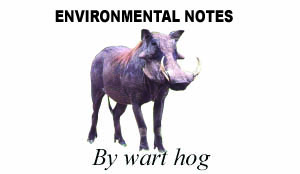 WART hog received phone calls from people trying to find out why celebrating Earth Day on the 19th of March when it is supposed to be on the 22nd April. For a moment Wart hog was also confused to hear that but colleagues for sure Earth Hour is different from earth day.
WART hog received phone calls from people trying to find out why celebrating Earth Day on the 19th of March when it is supposed to be on the 22nd April. For a moment Wart hog was also confused to hear that but colleagues for sure Earth Hour is different from earth day.
Earth Day is celebrated around the time of the March Equinox, others observe the occasion on April 22 each year. Earth Day aims to inspire awareness of and appreciation for earth’s environment.
While Earth Hour is an annual environmental campaign that brings attention to the effects of climate change by asking people to switch of lights at homes and businesses for an hour at 8.30pm (20:30), local time.
And as for Zambia this year WWF Zambia brought organisations together to celebrate this year, and the event was held on 19th March 2016, at East Park Mall along the Great East Road here in Lusaka with the global theme “Shine a light on climate action” and the mantra “Switching on renewables” added for our local context.. It is an event that aims to create awareness of people taking responsibility towards a sustainable future by turning the lights off.
Some people enjoy Earth Hour with a candle-lit dinner or a candle-lit bath, while others host large events or parties, either in darkness or with candles, to celebrate Earth Hour.
Businesses and government organisations, as well as community and political leaders also take part in Earth Hour.
It’s about giving people a voice on the planet’s future and working together to create a sustainable low carbon future for planet earth.
Earth Hour started in Sydney, Australia, in 2007. This event saw 2.2 million homes and businesses turn their lights off for one hour to make their stand against climate change that year. Earth Hour had become a global sustainability movement with more than 50 million people across 35 countries participating in 2008.
Global landmarks such as the, Sydney Harbour Bridge, the CN Tower in Toronto, the Golden Gate Bridge in San Francisco, and Rome’s Colosseum, all stood in darkness for Earth Hour. In March 2009, hundreds of millions of people took part in the third Earth Hour.
WWF, which organises the annual Earth Hour event, aims to stop the degradation of the Earth’s natural environment. It also focuses on building a future where people live in harmony with nature. The organisation functions through a network of more than 90 offices in more than 40 countries worldwide. Its first office was founded in Morges, Switzerland, on September 11, 1961.
From this year’s theme for Earth Hour Wart Hog also thought that to support renewables may have various drivers other than climate‐change mitigation. Including the following:
1) A contribution to increased energy security, reduced dependence from imported fossil fuels.
2) Hedging against price volatility and long‐term price increase of fossil fuels.
3) A contribution to the reduction of other pollutants and related risks arising from the use of other energy sources;
4) and a willingness to develop local employment, sometimes reinforced by a perception of the first mover’s advantage. While a unique policy instrument might work well when one objective is pursued, it is more likely that several objectives pursued together will require several policy instruments.
When it comes to overlapping CO2 and RE policies, the additional cost imposed on the achievement of the CO2 target by the RE policy instrument might be simply considered the cost of reaching the other objectives pursued by this policy instrument
These arguments are valid. Renewable technology deployment offers many benefits beyond its contribution to climate change mitigation, which need to be assessed and valued.
However, the benefits may fall short in justifying the extra cost. Indeed, as will be shown, the energy options displaced by RE technologies would have also provided, at least in part, similar benefits.
With respect to CO2 emissions from fossil fuel combustion, possible emission reductions all belong to energy efficiency improvements, fuel switching to fuels with lower carbon content (usually from coal to natural gas in electricity production), nuclear or renewable, or carbon capture and storage.
It is important to consider how these options fare relative to the other objectives possibly attributed to the policies supporting RE deployment.
Energy efficiency improvements contribute as much or perhaps more than RE to all the objectives assigned to RE policies.
They reduce other pollution, increase energy security and often create local jobs (e.g. for home insulation).
Fuel switching may or may not contribute to increased energy security, depending on the resources of the country considered, and its relationships to exporting countries.
It usually reduces other pollution along with CO2 emissions, for burning natural gas usually entails lower NOx, SOx, heavy metals and particulate emissions than burning coal.
Carbon capture and storage increases fuel consumption, and thus does not provide any hedge against price volatility and long‐term price increase.
It may, nevertheless, be considered to increase energy security in a carbon constrained world for countries with coal resources (or even without, considering a possible diversification in fuels and providers). It captures and stores most atmospheric pollutants as well as CO2.
Wildlife & Environmental Conservation Society of Zambia
P.O. Box 30255, Lusaka, Zambia.
Telefax: 260-211-251630, Cell: 0977-780770
E-mail: wecsz@coppernet.zm
or wecszzam@gmail.com






